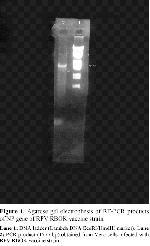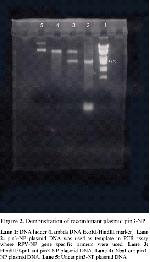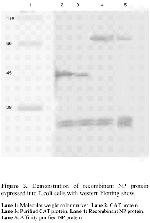Cells and Virus: African green monkey kidney (Vero) cells (Foot and Mouth Disease Institute, Ankara, Turkey) were cultured in Dulbeccos Modified Eagles Medium (DMEM, Sigma Chemical Co. St. Louis, MO, USA) containing 10% fetal bovine serum (Sigma), penicilin (100 IU/ml) and streptomycin (100µg/ml). RPV-RBOK vaccine strain adapted to cell culture as produced in the Etlik Research Institute was used in this study.
Total RNA Isolation: Approximately 65-75% of confluent Vero cells were infected with the RPV-RBOK vaccine strain. When cytopathological effect (CPE) was observed in approximately 80% of the cells, total RNA isolation was performed with TRI-Reagant (Sigma) as described by the manufacturer.
Reverse Transcription (RT) and Polymerase Chain Reaction (PCR): To design the NP gene spesific primers, EMBL gene bank X68311 RPV-RBOK vaccine strain gene sequence was utilized. According to the gene sequence, the forward primer (NP1: 5' GG AAG CTT ATG GCT TCT CTC TTG A 3') and reverse primer (NP2: 5' GG GGT ACC TCA GTT GAG AAT ATC 3') were created. HindIII enzyme cut site was added to the forward primer, and KpnI enzyme cut site was added to reverse primer. The reverse primer was used to make cDNAs of the nucleoprotein gene by using RT. Using these cDNAs as templates, 10pmol reverse and forward primers, 1.25mM dNTP (Promega), 25mM MgCl2 (Promega), 10X PCR buffer (Promega), 2U Taq DNA Polymerase (Promega), and 50µl PCR mixture were prepared. After preheating at 95ºC for 2 minutes, the PCR was performed containing 32 cycles with denaturation 94ºC for 1 minute, annealing at 44ºC for 1 minute, extension at 72ºC for 5 minutes and final extension at 72ºC for 15 minutes. PCR products were visualized on 1.5% agarose gel stained with ethidium bromide 10.
Construction of Recombinant pin3-NP Plasmid: Both RPV-RBOK vaccine strain NP gene and prokaryotic expression vector PinPointTMXa-3 (Promega) were cut with HindIII and KpnI restriction enzymes and purified from the agarose gel using the Wizard PCR Preps DNA Purification System (Promega, A7170) in accordance with the protocol of the manufacturer. The ligation reaction using T4 DNA Ligase enzyme was carried out. Using alkaline lysis method, the recombinant plasmid DNA was obtained from the transformed competent E.coli JM109 cells. The recombinant plasmid pin3-NP was identified XbaI, HindIII and KpnI digestion. Furthermore, PCR was performed using recombinant plasmid DNA as a template with the primers specific to the NP gene 11.
Production of Recombinant Biotinylated NP Protein: Procedures for the expression of recombinant biotinylated NP protein were as described by technical manufacturer. Recombinant plasmid pin3-NP and control vector were transformed to JM109 cells of E.coli. Transformed cells were inoculated to LB agar containing 100µg/ml ampicillin and kept at 37ºC for 16 hours. E.coli strain JM109 carrying the recombinant plasmid and control plasmid was grown for overnight in LB medium containing 100µg/ml ampicillin and 2µM biotin at 37ºC. Overnight cultures were diluted 1/5 in 25ml LB medium with 100µg/ml ampicillin and 2µM biotin. After four hours of culture at 37ºC, the expressions of recombinant biotinylated NP protein and CAT protein were induced by addition of 200µM IPTG and cultures further incubated at 37ºC for 5 hours with shaking.
Cell Lysis and Affinity Purification of Recombinant NP Protein: The cells were centrifuged at 8000 rpm for 10 minutes and the supernatant was removed. The cells were incubated with 1ml of ice cold cell lysis buffer (50mM Tris-HCl pH 7.5, 50mM NaCl, 5% glycerol) placed on ice and cells were resuspended. Then lysozyme was added to a final concentration of 1mg/ml and mixture was stirred at 4ºC for 1 hours. After adding sodium deoxycholate (DOC) to a final concentration of 0.1%, stirring was continued for an additional 15 minutes. Finally, 200U DNase I was added to reduce viscosity of the solution, then stirred for 20 minutes at 4ºC. The cell lysate was centrifuged at 10000 rpm for 10 minutes at 4ºC, so that remove cell debris. Then the supernatant was transferred to a clean tube. After the supernatant was mixed with 75µl SoftLinkTMResin and stirred gently for 2 hours at 4ºC. The resin was washed throughly with cell lysis buffer twice and was added to the resin suspension up to concentration of 5mM in order to elute the resin bound protein fraction. Then, allow the resin to settle and purified protein to a clean tube transferred.
SDS-PAGE and Western Blotting: To determine the production of recombinant protein in expressed E.coli SDS-PAGE was carried out. Firstly, pour off 10% resolving gel on electrophesis apparatus, when polymerization is complete and pour off stacking gel solution directly onto the surface of the polymerized resolving gel. While the stacking gel is polymerizing, the samples prepared by heating to 100ºC for 3 minutes in 1XSDS gel loading buffer (50mM TrisCl pH6.8, 100mM dithiothreitol [DTT], 2% SDS, 0.1% bromophenol blue, 10% glycerol) for denature proteins, after the samples were load up into the bottom of the wells. The samples were run at 150V current for 4 hours. Then, proteins were transferred onto nitrocellulose membran at 10mA current for 1 hours. After transfer process, the membran was blocked with 5% nonfat dried milk at 37ºC for 1 hours. The membran was washed with TBST buffer (10mM TrisCl pH8.0, 150mM NaCl, 0.05% Tween20) five times, the membran was incubated with 1/500 dilution streptavidin (Kpl, USA) at 37°C for 1 hour. The membran was washed with TBST buffer. Then, the membran were left into a chromogen substrate solution containing 0.1% diamino benzidine tetrachloride DAB (Sigma, USA) and 0.02% H2O2 for a period of time for monitoring.





